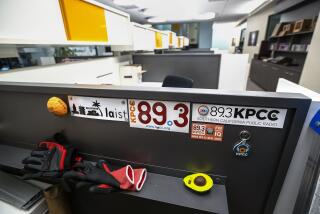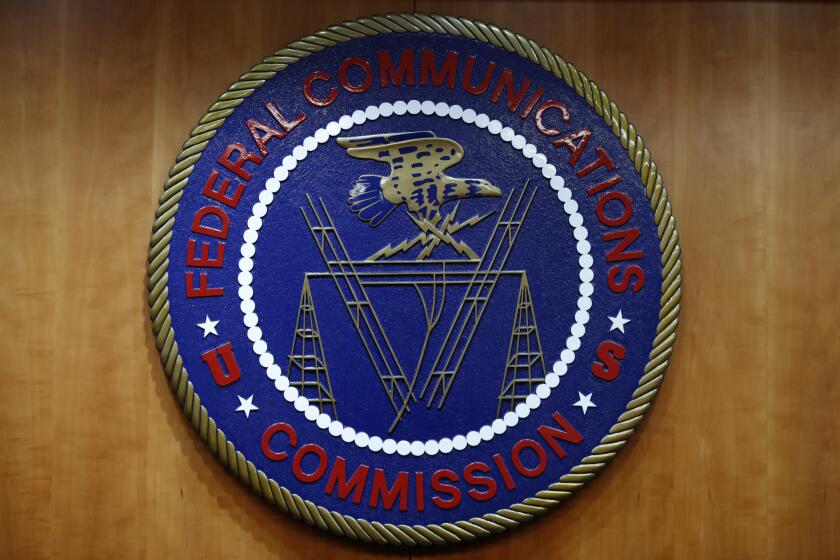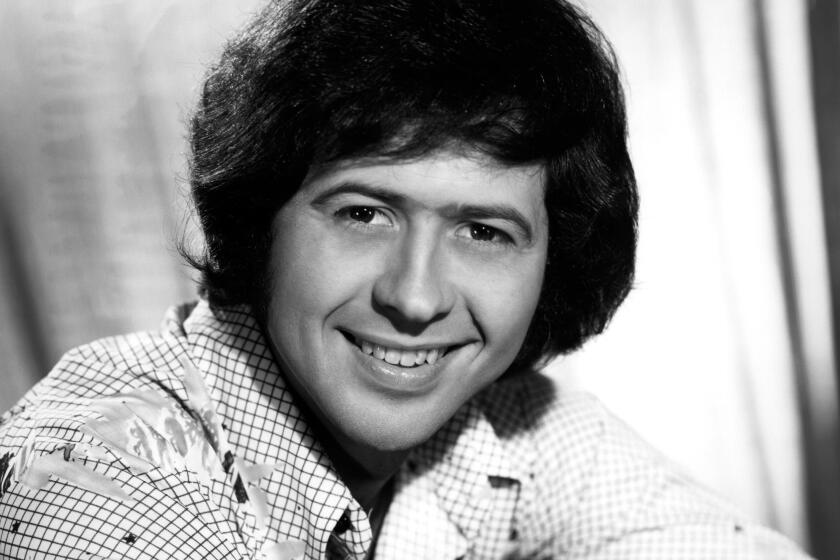Picture Goes Dim at Many Independent TV Stations
NEW YORK — It was Milt Grant’s Texas deal that cinched his reputation.
He bought two struggling television stations in Dallas and Houston, spent fearlessly on programming to pump up their ratings and revenue, and in two years sold them for a $176-million profit on a $12-million investment. It was a feat of alchemy that lured scores more entrepreneurs to the independent, or non-affiliated, television industry.
It is because Grant’s skills are legend that the industry was startled to learn this month that he has asked those who supply programs to his Grant Broadcasting System to reduce the amounts they are owed, which last year totaled $180 million. Grant told stunned program syndicators last week that the financial problems of his three-station company firm are “acute, and not about to get better,” one syndication executive said.
“It’s pretty amazing to see this guy out there, hat in hand,” the syndicator added.
Grant’s difficulties may provide the most dramatic example yet of how slumping advertising demand, growing competition and a dizzying rise in program costs threaten so many of the nation’s smaller, non-network TV stations.
While TV properties are still widely perceived as cash machines, owners of more and more stations have been forced to beg for relief from their debts, convert to less-expensive specialized programming formats, or sell out at fire-sale prices.
As many as 60 of the nation’s 220 commercial “indies” may be for sale, and as much as $1 billion in programming debts may be shaky because of these pressures, say brokers and industry officials. Only last week, the weakness of the market was evident as Taft Broadcasting announced that it would sell five independent stations for $240 million--less than half what some analysts had earlier expected.
“There’s blood in the streets,” said Fred Eychaner, general manager of independent station WPWR in Chicago.
Gloom was giddy optimism only months ago. Rupert Murdoch, after all, paid a breathtaking $1.6 billion for six Metromedia stations in April, 1985, and later last year, Tribune Co. of Chicago paid a record $510 million for Los Angeles’ KTLA Channel 5.
Those sales represented the peak of a market that had been gaining altitude for five years. It began heading upward when the Federal Communications Commission abandoned rules barring stations owners from selling their properties until they had owned them two years. The purpose of that rule was to prevent speculation in TV properties.
Then, in the early 1980s, Wall Street investment firms that had been leery of stations because of their lack of hard assets began to be drawn by their ability to generate cash, said Steven Pruett, a station owner and broker with Blackburn & Co. in Chicago. “Then the game really got going.”
The independents often broadcast on the UHF rather than the VHF band, and thus often don’t have the larger broadcast range that would deliver bigger audiences and ad revenue. Their silk-stocking relatives, the network affiliates, have an easier job attracting audiences because of their network prime-time programming, which also costs affiliates less than the independents pay for recycled situation comedies, sports, movies and games shows that are their standard fare.
Typically, independents spend 50% of revenue for programming, while network affiliates pay only about 20%, estimates Jeffrey E. Epstein, investment banker with New York’s First Boston Corp. who specializes in media companies.
Number Tripled
Despite those drawbacks, the number of independent stations tripled, to a current 220, between 1979 and 1986. Many of the new entrepreneurs intended to follow the strategy, pioneered by Grant, of buying premium programming--even at high prices--grabbing good ratings that convert instantly to higher ad revenue, and then selling out for a princely premium.
Prosperity seemed inevitable as long as advertising revenue grew at double-digit rates, as they did between 1980 and late 1985. Even last year, many entrepreneurs “thought it took just a construction permit, $2 million in start-up capital, and bingo, you’d be printing money,” said Alice Frentz, vice president with Shawmut Bank in Boston.
But the outlook had been changing as the proliferation of stations increased demand for programming. While affiliates’ programming costs grew 15% to 20% a year, many independents had to absorb increases of 25%, says Trey Hunt, a vice president and television finance specialist with Butcher & Singer, a Philadelphia investment firm.
Reruns of “MASH” were the most expensive programs in 1979, at $250,000 per episode. When it was reoffered to stations for a new cycle of showings five years later, “MASH” brought $900,000 a episode, said First Boston’s Epstein. “Usually, you expect a lower price when they offer the show again.”
Independents in the biggest markets, such as New York and Los Angeles, have such large audiences and huge advertising bases that they are relatively untouched. Los Angeles’ big KTLA, KTTV, KCOP, and KHJ independents have long had impressive audience shares.
But many independents in the smaller metropolitan areas--particularly those that are the third or fourth independent stations--have recently seen their slice of the local advertising pie grow dangerously slim.
Signs of Distress
There have been signs of the independents’ impending distress for some time. In mid-1985, KNAT, an Albuquerque, N.M., station owned by entertainer Johnny Carson, playwright Neil Simon and others, went dark. Industry observers took its problems partly as a sign that the fever for independent stations had drawn inexperienced managements to the business.
Other casualties included New Orleans station WNOL, which was flattened by a huge debt load and purchased on the cheap by TVX Broadcast Group. One financier joked that its call letters might have stood for “net operating loss.”
Investment banker Drexel Burnham Lambert and some of its principals became enmeshed in the problems of independent WTTV in Indianapolis. Drexel is a 5% shareholder, and its principals hold another 20% after a buyout financed with high-risk “junk bonds” two years ago by a group that also includes some station management.
Lorimar-Telepictures agreed last July to buy the station essentially by assuming $85 million in debts. These days, however, Lorimar officials are saying that the price may need to be renegotiated downward, in light of the advertising market’s weakness, and perhaps also the nervousness that has hit the junk bond market since the insider trading scandal hit Wall Street in recent weeks.
But the problems of Grant Broadcast System may provide the most striking illustration of the industry’s difficulties.
Sought Bigger Markets
After selling his Dallas and Houston stations to Gulf Broadcasting in January, 1985, Grant and backer Sidney Schlenker, who is majority shareholder in the Denver Nuggets basketball team, decided to move on to bigger markets. With the help of Drexel Burnham Lambert, they raised $125 million in equity, bank loans and privately placed junk bonds to make winners out of tiny independents stations WFBN in Chicago, WBFS in Miami and WWSG in Philadelphia.
Grant declined repeat requests for an interview for this story, but a confidential memorandum issued late last year in connection with the bond sale shows that Grant Broadcasting’s strategy with the new stations was similar to the one he had used in Texas.
The company would buy low-priced stations, spend heavily on programming and promotion to turn them into top independents while the competition napped. The memorandum shows that a year ago, the new company had already accumulated programming obligations of $180 million, an unusually heavy load for three small stations in any market.
Grant spent big on promotion and programming. The company swept into Miami with a 60-day promotional blitz that industry sources say cost $2 million.
“I checked into a hotel down there then, and even the bellhop knew about Grant and his station,” said Michael Finkelstein, president of Odyssey Partners, which owns WDZL-TV in Miami.
But Grant Broadcasting didn’t figure on the slowdown in advertising, and may also have been surprised by his competitors’ willingness to match his bids for programming. “This time we saw him coming,” one competitor said.
Game Prices Soared
In Miami, Grant bought rights to run some New York Yankees baseball games, but had to pay $16,000 a game, compared to $6,000 a game that Taft Broadcasting’s station had paid in the previous auction.
So while Grant largely got the ratings he wanted, he did not draw the revenue needed to meet his debts. Chicago, which has six other commercial independent stations, and Miami, which has five others, have been the biggest headaches, industry sources say.
Will Grant Broadcasting be allowed to pay less for programming? “I don’t think we could agree to something like that,” said Michael Lambert, executive vice president of 20th Century Fox, a Grant creditor.
If the new industry climate has overwhelmed veteran broadcasters, it has complicated the lives of less experienced station owners as well.
One of them is Arnold Chase, the scion of one of Hartford’s most prominent families, who is president of independent WTIC in the Connecticut city. Chase set out to win a license for what he hoped would be Hartford’s first independent TV station, and after four years of FCC deliberations, he prevailed over such major broadcast players as Gene Autry’s Golden West Broadcasting.
But Chase wasn’t the only one to see potential wealth in a station in Hartford, one of the nation’s most affluent markets. Three other independents have now joined him to jostle for a share of the market, and a fifth has a license and would be on the air if it could secure financing.
Adding to the complications, at any moment more than one-quarter of Hartford viewers are watching stations in Boston, New York, or other out-of-town stations. “All in all, this market’s turned out to be a bit tougher than it looked a few years ago,” he said.
Heavy Losses Seen
Chase won’t comment on his company’s finances, but industry sources say he has lost more than $12 million--a sum that’s coming directly from the Chase family fortune--in the past three years. This month, they say, the station laid off at least 15 employees.
Some of WTIC’s competitors are in difficulty as well. One, WHCT, has disclosed that it is losing $10,000 a week.
Chase says programming expenses have already begun to slide in the market because of the financial problems of the stations. And he is pinning much of his hope on ties with the new Fox Broadcasting network, which now pays his station to run four hours of programming, including its flagship, “The Late Show” starring Joan Rivers.
Next spring, Fox will be providing 10 hours of programming a week, Chase says, predicting that the programming “will really set us apart.”
Other independents are pinning their hopes on a buyout from a larger general broadcaster, or by specialty programmers such as the new cable television home shopping stations, religious or Spanish language broadcasters, said David Schutz, a investment banker with Comcapital Group in New York.
“If the advertising isn’t there for your station, you’ve got to switch to a lower cost format,” he said.
Home Shopping Network, which sells marked-down goods on cable television, has so far purchased nine independent stations, including KIHS, a struggling Ontario, Calif., station. The network has also ignited a war with syndicators by refusing to pay any amounts owed by the stations for past programming.
Press for Bankruptcy
Paramount Pictures, 20th Century Fox and MCA Television have asked a federal court to declare Home Shopping Network’s recently acquired WCLG-TV in Cleveland bankrupt because it won’t pay $387,000 the syndicators say they are owed. Embassy Communications, producer Norman Lear’s production and syndication firm, has also asked the FCC to bar Home Shopping’s acquisition of WCLQ and WKJL in Baltimore because the stations have reneged on their obligations to Embassy.
These are not the only syndicators worried about independents meeting their obligations. Charles Larsen, executive vice president of D. L. Taffner Ltd. in New York, says his company has received at least four times as many requests for relief this year than last.
While the pressures have apparently not yet been fatal for any syndicator, Larsen predicts that defaults on such obligations may ruin some smaller firms that distribute only one or two programs and thus are more vulnerable. “There’s never been a time before when people didn’t come up with what they owed,” he said. “For the syndication business, that’s a pretty big shock.”
Butcher & Singer’s Hunt says that despite the industry’s travail, many still burn with passion to buy independent stations. “Amazing as it sounds, I still hear people say, ‘I’ve got this incredible prospect,’ ” he says.
More to Read
The biggest entertainment stories
Get our big stories about Hollywood, film, television, music, arts, culture and more right in your inbox as soon as they publish.
You may occasionally receive promotional content from the Los Angeles Times.











